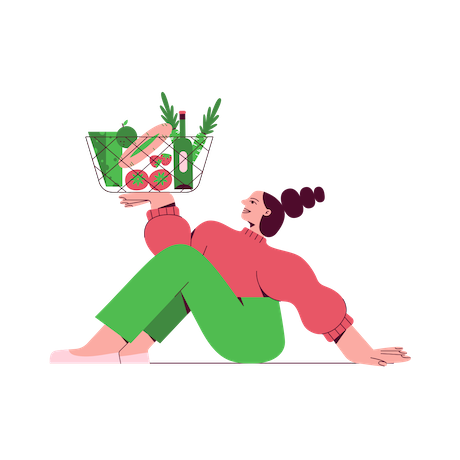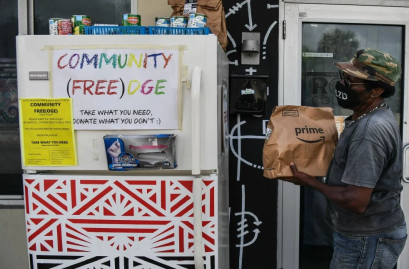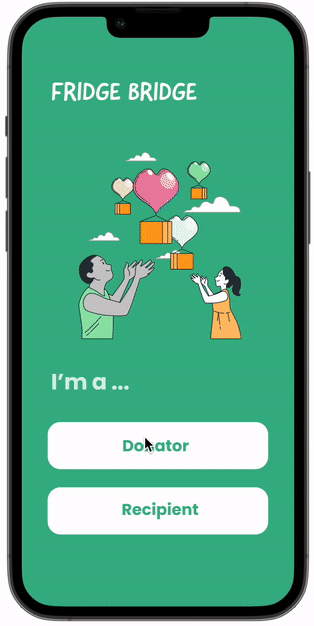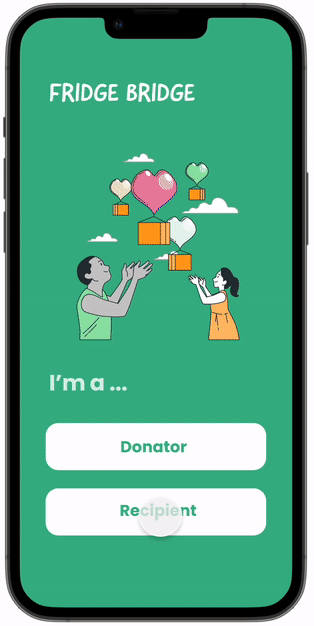Context
Fridge Bridge is made from a 2-day UX Hackathon, held by UX@UW and Figma. The project was completed in 24 hrs, and won the “Most Impactful Idea” prize.
The Problem Between Too Much and Too Little
$200 billion
spent on food that will never be eaten
273k tons
of food is wasted by WA residents annually
1 in 8 Americans
experience food insecurity
Design Question
How might we reduce the amount of edible food wasted and mitigate food insecurity by bridging people who have excess and people who have too little?
My Role
UX Designer
My Team
Rohan Kalantri (Product Manager)
Ziyun Tie (UX Researcher)
Zoie Huang (UX Designer)
Tools
Figma, Fig Jam
Who Do We Serve?
Food Donator
❌ Having to throw excess yet edible food away
✅ Giving excess, safe, edible food to others and receive point incentive that discounts the next grocery run
Food Recipient
❌ Wondering where the next meal will come from since other similar facilities don’t fit my need
✅ Reserve and pick up needed/desired food any time at places near me
How Do We Meet Their Goals?
For Food Donator
Provide transparency of donation impact
Make donating food a habit
Make the process of donating easy and flexible
Incentivizing donations to encourage continued engagement
For Food Recipient
Provide access to a variety of fresh food to be choose from
Streamlining the process of locating desired food
Making the process of picking up food flexible and contact-less to fit their needs
Desk Research
We conducted desk research to learn about food waste and food insecurity in Washington and in the U.S. The data insights helped us pitch the values of our product to stakeholders.
Key data:
1 in 8 Americans have food insecurity while $200 billion is spent on food that will never be eaten.
40% of food produced, processed and transported in the U.S. is wasted.
50% of the U.S. land, 80% of fresh water, and 10% of the energy budget is spent bringing food to us.
Competitive Analysis
We analyzed the pros and cons of several existing solutions to inspire our design strategies.
Key takeaway:
Ensure food donated by individuals is safe
Make sure recipients get access to the right amount of food.
Make pick-up food contact-free for recipients
Communal Fridge
Too Good To Go App
Food Bank
User Interviews
We interviewed with 4 participants to further understand their needs.
Main question areas:
Previous experience on donating or receiving food
Pain points regarding donating or receiving food
Motivations to donate or receive food.
Key insights
Give incentive to donators.
Let both donators and recipients be aware of the positive impact of their engagement.
Set up reasonable time limits for donators to drop off food and for recipients to pick up food.
User Flow
Visualize Ideas
Step 1:
Partner with chain stores and grocery stores to install Fridge Bridges at their locations.
Step 2:
Donators and recipients enter the one-time code we send them via our app and messages.
Step 3:
Donators and recipients access the Fridge Bridge to drop off or pick up food.
Wireframing
Donators flow:
Recipients flow:
Design Solution
How to Share Your Excess Food?
Sign in as a donator.
Read instructions to start.
Upload donated food images and enter relevant info.
Select a Fridge Bridge and receive a one-time code to drop your food.
Drop your food within 12 hours.
Receive incentive for donation.
How to Gain Safe & Quality Food?
Sign in as a recipient.
Read instructions to start.
Select a Fridge Bridge near you.
Make a reservation on an available box in the Fridge Bridge and receive a one-time code.
Pick up food inside the box within 1 hour.
See how you contribute to reducing food waste.
About the 💰
Sales Model:
Monthly subscription: Partners will pay fixed monthly cost and we will install a Fridge Bridge at their location. No maintenance required from partners and the subscription can be cancelled anytime.
One-time purchase: We sill install a Fridge Bridge at a partner’s location after payment. Basic support is provided and API can be added to their mobile app.
What’s in it for the partners:
Additional marketing avenue
More footfall in stores
Measurable impact created
Direct contributions to reducing food waste
Costs to a Fridge Bridge:
Product development
App development
Manufacturing
Maintenance
Reflection
There’s some quantity limitation and time limitation I set up within the user flow. Donators need to drop their food at a Fridge Bridge within 12 hours to guarantee the quality of food. Recipients need to pick up their reserved food within 1 hour because we want to ensure people who really need food would have access to it. There're 4 food items maximum inside a box in a Fridge Bridge and recipients can only reserve a box at a time. This is to make sure recipients get access to the right amount of food and make the operation of a Fridge Bridge as simple as possible. This is the best solution I can bring forward within 24 hours. But if we have more time, we can make the process of donating and receiving food more flexible and personalized.
This was the first time I participated in and won a Hackathon. When I look back, I think one big reason why we can win is that each of us understands our own strengths very well. We make sure we complete our own tasks on time and work together at each stage to support each other. This was a very positive collaboration experience.




















